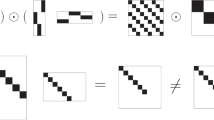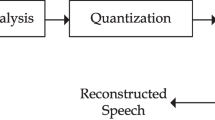Abstract
Structural and statistical characteristics of signals can improve the performance of Compressed Sensing (CS). Two kinds of features of Discrete Cosine Transform (DCT) coefficients of voiced speech signals are discussed in this paper. The first one is the block sparsity of DCT coefficients of voiced speech formulated from two different aspects which are the distribution of the DCT coefficients of voiced speech and the comparison of reconstruction performance between the mixed l 2 / l 1 program and Basis Pursuit (BP). The block sparsity of DCT coefficients of voiced speech means that some algorithms of block-sparse CS can be used to improve the recovery performance of speech signals. It is proved by the simulation results of the l 2 / reweighted l 1 mixed program which is an improved version of the mixed l 2 / l 1 program. The second one is the well known large DCT coefficients of voiced speech focus on low frequency. In line with this feature, a special Gaussian and Partial Identity Joint (GPIJ) matrix is constructed as the sensing matrix for voiced speech signals. Simulation results show that the GPIJ matrix outperforms the classical Gaussian matrix for speech signals of male and female adults.
Similar content being viewed by others
References
M. Stojnic, W. Y. Xu, and B. Hassibi. Compressed sensing of approximately sparse signals. IEEE International Symposium on Information Theory, Toronto, ON, Canada, 2008, 2182–2186.
R. G. Baraniuk. Compressive sensing. IEEE Signal Processing Magazine, 24(2007)4, 118–121.
D. Donoho. Compressed sensing. IEEE Transactions on Information Theory, 52(2006)4, 1289–1306.
E. J. Candès. Compressive sampling. Proceedings of the International Congress of Mathematicians, Madrid, Spain, 2006, 1433–1452.
Y. C. Eldar and M. Mishali. Robust recovery of signals from a structured union of subspaces. IEEE Transactions on Information Theory, 55(2009)11, 5302–5316.
S. Chen, D. L. Donoho, and M. A. Saunders. Atomic decomposition by basis pursuit. SIAM Journal of Scientific Computing, 20(1999)1, 33–61.
R. G. Baraniuk, V. Cevher, M. F. Duarte, and C. Hegde. Model-based compressed sensing. IEEE Transcations on Information Theory, 56(2010)4, 1982–2001.
E. J. Candes. The restricted isometry property and its implication for compressed sensing. Compute Rendus de I’Academie des Science, Paris, France, 2008, 589–593.
E. J. Candes and T. Tao. Decoding by linear programmming. IEEE Transactions on Information Theory, 51(2005)12, 4203–4215.
J. N. Laska, M. A. Davenport, and R. G. Baraniuk. Exact signal recovery from sparsely corrupted measurements through the pursuit of justice. 43rd Asilomar Confernce on Signals, Systems and Computers, Pacific Grove, CA, USA, 2009, 1556–1560.
Z. Li, F. Wu, and J. Wright. On the systematic measurement matrix for compressed sensing in the presence of gross errors. Data Compression Conference Proceedings, Snowbird, UT, USA, 2010, 356–365.
S. Dasgupta and A. Gupta. An elementary proof of the Johnson-Lindenstrauss lemma. ICSI Technical Report TR-99-006, 1999.
M. A. Davenport. Random observations on random observations: sparse signal acquisition and processing. [Ph.D. Dissertation]. Rice University, 2010, 49–58.
R. G. Baraniuk, M. A. Davenport, R. Devore, and M. B. Wakin. A simple proof of the restricted of isometry property for the random matrices. Construction Approximation, 28(2008)3, 253–263.
M. Stojnic. Block-length dependent thresholds for l 2 / l 1-optimization in block-sparse compressed sensing. IEEE International Conference on Acoustic, Speech and Signal Processing-Proceedings, Dallas, TX, USA, 2010, 3918–3921.
E. J. Candes, M. B. Wakin, and S. P. Boyd. Enhancing sparsity by reweighted l 1 minimization. Journal of Fourier Analysis and Applications, 14(2008), 877–905.
Z. L. Zhang and B. D. Rao. Sparse signal recovery with temporally correlated source vectors using sparse bayesian learning. IEEE Journal on Selected Topics in Signal Processing, 5(2011)5, 912–926.
Author information
Authors and Affiliations
Corresponding author
Additional information
Supported by the National Natural Science Foundation of China (No. 60971129), the National Research Program of China (973 Program) (No. 2011CB302303), and the Scientific Innovation Research Program of College Graduate in Jiangsu Province (No. CXLX11_0408).
Communication author: Ji Yunyun, born in 1988, Ph.D..
About this article
Cite this article
Ji, Y., Yang, Z. & Xu, Q. Compressed speech signal sensing based on the structured block sparsity with partial knowledge of support. J. Electron.(China) 29, 62–71 (2012). https://doi.org/10.1007/s11767-012-0761-7
Received:
Revised:
Published:
Issue Date:
DOI: https://doi.org/10.1007/s11767-012-0761-7




